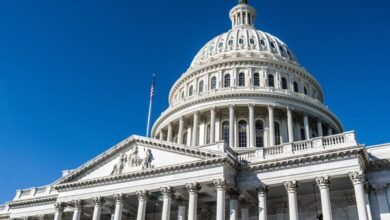Is Luigi Mangione Too Big to Jail?

▼ Summary
– Luigi Mangione, accused of murdering UnitedHealthcare CEO Brian Thompson, appeared in court for a hearing where two terrorism-related charges were dropped in a significant defense win.
– Public interest in the case remains high but has waned since February, with supporters and media still gathering despite smaller crowds and increased security measures.
– Mangione’s case has sparked discussions on healthcare reform, with groups like People Over Profit NYC organizing rallies to maintain focus on systemic issues.
– The defendant faces three concurrent criminal cases in New York, Pennsylvania, and federal court, with ongoing legal arguments around double jeopardy and trial sequencing.
– Mangione’s public persona is heavily influenced by social media and viral imagery, complicating serious legal proceedings and public perception of the case.
The line began forming days in advance, a testament to the enduring public fascination with Luigi Mangione, the man accused of killing UnitedHealthcare CEO Brian Thompson in late 2024. By Tuesday morning, the scene outside the Manhattan courthouse was both familiar and subdued, smaller than the circus-like atmosphere of February, but no less intense. Supporters, protesters, and media crews gathered once more, drawn not only by the legal proceedings but by the larger questions about justice, healthcare, and public spectacle that Mangione’s case continues to provoke.
This time, court officials appeared better prepared. Rather than allowing crowds to pack the hallways, they kept most observers outside on the sidewalk. The more controlled environment did little to dampen the dedication of those determined to witness the hearing. Some had camped out overnight, their hands marked with self-assigned numbers in a makeshift effort to bring order to the queue. Mason Alexander, who managed to attend the first hearing months earlier, arrived at 11 PM only to find himself 25th in line, too far back to secure a spot inside this time. He explained that while he doesn’t condone violence, the case resonated with him because it forced a public reckoning with systemic issues in American healthcare.
Nearby, the group People Over Profit NYC held a rally, complete with protest signs, homemade merchandise, and a spinning wheel satirizing insurance claim outcomes. Yet turnout was noticeably lighter. One anonymous attendee pointed to “protest fatigue” and the early hour, but also alluded to a broader climate of fear. In the wake of recent political violence, including the killing of right-wing commentator Charlie Kirk, many supporters may have hesitated to be publicly associated with Mangione. Online doxxing and employer reports have made visibility risky, even for those expressing sympathy rather than endorsement.
The hearing itself delivered significant legal developments. Judge Gregory Carro dismissed two terrorism-related charges against Mangione, determining that the prosecution had failed to demonstrate intent to intimidate or coerce the public, a major victory for the defense. Still, Mangione remains charged with second-degree murder in New York, in addition to separate state and federal cases elsewhere. His attorneys argued that trying him simultaneously in multiple jurisdictions constitutes double jeopardy, but Judge Carro rejected that motion. He also denied a request to pause the state case until after federal proceedings, which carry the possibility of the death penalty.
Visually, the day offered little new fodder for the ardent online followership that has elevated Mangione to near-mythic status. He appeared in standard khaki prison attire, restrained by shackles at his ankles, wrists, and waist, a point of continued objection from his legal team, who argue that such images prejudice public perception. Inside the courtroom, the atmosphere was tense and quiet. A faint reaction from supporters when the terrorism charges were dropped drew a sharp rebuke from court officers. Outside, the spectacle continued, blending earnest activism with the bizarre: Luigi-themed hats, viral speculation about his demeanor, and memes dissecting his every expression.
What makes this case so difficult to categorize, or ignore, is the way it lives in two worlds at once. On one hand, it involves a brutal assassination and complex legal arguments playing out across courtrooms. On the other, it has become a cultural phenomenon, sustained by social media engagement, visual virality, and grassroots mobilization. Mangione’s supporters hope that jury nullification might offer a path to acquittal, arguing that his act, though criminal, exposed grave injustices. But in an era of fragmented attention and short news cycles, maintaining momentum is an uphill battle.
There is a recurring rhythm to the coverage: a burst of visibility during court appearances, followed by weeks of quiet. As the hearing concluded, new photos of Mangione once again flooded social platforms. Friends texted updates in real time, just as they had months before. The central question lingers, unresolved: in a culture that often prizes narrative over nuance, can a defendant’s transformation into a symbol, whether celebrated or condemned, ultimately shape their fate? For now, all that is certain is that the eyes of the world will return to the courthouse in December, when Mangione is scheduled to appear again.
(Source: The Verge)







